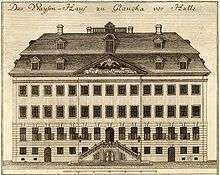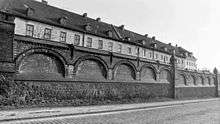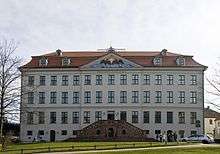Francke Foundations
The Francke Foundations (Franckesche Stiftungen), also known as Glauchasche Anstalten in Halle, were founded in 1695 as a Christian, social and educational work by August Hermann Francke (1663–1727), a Pietist, theologian and university professor in Halle, Germany. Francke Foundations are today a modern educational cosmos closely connected with their history. The Francke Foundations are on the German proposal list as a UNESCO World Heritage Site since 1999.

History
Origins
In the former outskirts of Halle, in Glaucha, August Hermann Francke established a school for the deprived and orphan children and elaborated an extensive, religiously motivated schooling and educational concept and started, at first without a steady income and without capital, to build up social-educational institutions for each class of society. Within only 30 years, Francke Foundations (Franckesche Stiftungen) developed, favoured and protected by the Elector of Brandenburg and King of Prussia through privileges, into a unique school city with a teacher training institution, business enterprises such as a pharmacy, a publishing house and scientific collections.
Today Francke Foundations feel bound to a double heritage: the responsibility for the salvation and lasting preservation of the building ensemble and the historical collections as well as the task of continuing the ideas and traditions of their founder into the future. Since the revival of the Foundations in 1992 institutions, which have close connections to Francke's ideas and work, have been settled into the historical buildings. With their 40 partner institutions the Foundations are today a unique centre of cultural, scientific, educational, social and Christian institutions, a complex with three kindergartens, children’s creativity centre, four schools, a House of Generations, a youth workshop, a bible centre, traditional commercial enterprises, archives, libraries, museums, university and non-university research facilities and much more. Today more than 4,000 people learn, teach, work and live in the Francke Foundations.
From charity school to the orphanage – August Hermann Francke (1663–1727)
August Hermann Francke was appointed as pastor in December 1691 at St. Georgen Kirche in Glaucha – since 1817 an urban district of Halle - and as a professor for Greek and oriental language at the Friedrichs University of Halle. Confronted with the conflicts of his time, he started a reform within the Lutheran church based on a new and individual piety. Francke developed a comprehensive religious school and education concept and started to create educational institutions for each social class. A high contribution on Easter 1695 was the basis for his life work. Immediately after receiving this contribution, Francke established a charity school in his vicarage. Poor children had been lectured by students from the University and within a short period of time the number of children increased. The good reputation of lecturing getting about and citizens of Halle send their children to Francke. Therefore, Francke founded in spring 1695 the Paedagogium, a school for higher education for members of nobility and middle class. The Latin school (Latina) was founded two years later and the orphanage in 1698. Thanks to a lot of contributions and due to tax and other privileges from the King of Prussia, Francke was able to build the Orphanage, a lavish building compare to conditions of time, which was finished in 1701. In the tympanum of the Orphanage, which is decorated with two eagles rising up to the sun, is written (Isaiah 40:31) “But those who wait for the Lord’s help, find renewed strength; they rise up as if they had eagles’ wings, they run without growing weary, they walk without getting tired.” Francke Foundations was quickly considered by contemporaries to be the "New Jerusalem". The Foundations formed a global correspondence network that spread the reform plans of Halle Pietism all over the world. Evidence of this can still be found today in many European countries, in South India, Russia, Poland and the USA.
18th–19th century
Thanks to a wide range of electoral privileges, Francke Foundations was able to establish a publishing house, a book store, a printing office, a pharmacy and a Cabinet of Artefacts and Curiosities. The revenues fund the orphanage and in 1709 a timbered, three-storey house for orphan girls and a girls' school were established. A year later, the English house for students from England and abroad was built and in 1711 another building. In the basement of this building is a dining hall and in the upper floor a huge prayer and singing hall with a capacity of 2,000 persons.
In 1711, August Hermann Francke and his friend and supporter, the Prussian baron Carl Hildebrand von Canstein (1667–1719), established the Cansteinsche Bibelanstalt (Canstein Bible Institute), the oldest bible institute in Germany. Bibles were in the early 18th century extremely expensive. An invention in letter pressing, and with financial support by Carl Hildebrand von Canstein, had made it possible to produce very reasonably-priced Bibles in a large amount. Many people were now able to afford a Canstein Bible. Until the middle of the 20th century millions of Bibles had been published.
In the following years a number of buildings were built, e.g. the long house (Langes Haus) in 1713, the largest high-timbered five- and six-storey building. It houses today a hall of residents (Evangelisches Konvikt) and a boarding school for students of the Latina. In the upper Lindenhof (linden yard), the Ökonomiegebäude was built in 1747–48 as an administration house. It is, since 1808 the base of the Stadtsingechor, the oldest boys' choir in central Germany. The royal paedagogium (Königliches Pädagogium), built in his present form in 1848, was since 1711 an institute for higher education for members of the nobility. After redevelopment in 2005, it is a House of Generations (Haus der Generationen) with a primary Montessori school (Reformschule Maria Montessori), a nursing home (Altenheim der Paul-Riebeck-Stiftung) and a social consulting and education institution for families and health care (Familienkompetenzzentrum für Bildung und Gesundheit). In 1810 the Realschule was built and in 1835 girls' secondary school.
August Hermann Francke in Halle reports on the considerable volumes of reports and correspondence found in the "Kirchenbote fuer Religionsfreude aller Kirchen" published in 1783 in Dessau and Leipzig. Other rewarding studies can be made on the Hessian troops in Halifax with history of German settlers that represented more than 50% of the population speaking the German language between 1750 and 1759 (Elmore Reaman, Historian)[1]
After a time of flourishing development, times of decline followed in the late 18th century. August Hermann Niemeyer (1754–1828) took over direction and renewed the educational programs and financial issues and ensured the continuity of Francke Foundations.
19th–20th century
Because of the good reputation and its revenues, the Francke Foundations were growing and a new building for Lateinische Hauptschule (Latina) was built. In 1911 more than 3,000 students attended the various schools. During the time of National socialism Francke Foundations existed as a Christian formed school city in a balancing act of adjustment and rejection. During World War II some buildings, including the residential house of August Hermann Francke and the Latina, were damaged and destroyed in an air raid in March 1945.
In 1946, the presidium of the province of Saxony annulled the legal entity of the Francke Foundations and integrated these including their entire assets into the Martin Luther University Halle-Wittenberg. The Francke Foundations ceased to exist as self-determined Christian institutions, although the pedagogic tradition was continued through schools and the university's pedagogic institutes on the premises of the foundations.

The historic buildings were utilized, but an increasing decay couldn't be avoided. In the 1970s, the northerly Orphanage wall had been demolished to build an elevated road (Hochstraße) to connect Halle with Halle-Neustadt, a newly formed socialist city. This elevated road separates the Orphanage Pharmacy from other parts of the Foundations. On the ground of the Foundations, the former plantation, several high rises were built.
After the end of the GDR, Francke Foundations were re-established in September 1991, thanks to the commitment of the board of the Friends of the Francke Foundations founded in June 1990, and thanks to the support of the re-established federal state of Saxony-Anhalt. Extensive renovation measures could be carried out through the help of public and private donations, with the support of the German Foundation of Monument Protection (Stiftung Deutscher Denkmalschutz), the Federal Environment Foundation of Germany (Deutsche Stiftung Umweltschutz), with support from the regional government of Saxony-Anhalt (Landesregierung Sachsen-Anhalt) and of the Federal Government.
Current situation and activities

Today the Francke Foundations inhabit an outstanding architectural ensemble of buildings and are involved in a wide range of international co-operations. The buildings of the historical school city are almost completely restored and the ensemble has been revived as cultural and scientific, social and educational institution. On the grounds of the Francke Foundations there are now besides the institutions owned by the foundation – the Historic Orphanage, the Archives, the Historic Library and three kindergartens, children's creative education center Krokoseum – the Faculty of Theology and the Institute for Education, the Interdisciplinary Research Centres for Enlightenment Studies (Interdisziplinäres Zentrum für die Erforschung der europäischen Aufklärung) and Interdisciplinary Centre for the Studies in Pietism of the Martin Luther University (Interdisziplinäres Zentrum für Pietismusforschung), four schools (Landesgymnasium Latina "August Hermann Francke", Grundschule "August Hermann Francke", Reformschule Maria Montessori, Sekundarschule "August Hermann Francke"), a Protestant Seminary, a social workshop for young people, two church rooms (St. Georgs Kapelle, Orthodoxe Hauskirche zum Heiligen Kreuz) and the German Federal Cultural Foundation (Kulturstiftung des Bundes). The historic buildings and collections in the Historic Library, archives and cabinet of artefacts and curiosities witness the eventful history of the Francke Foundations today.
Cabinet of Artefacts and Curiosities
The Cabinet of Artefacts and Curiosities is considered to be Germany’s oldest museum. The collection was started by August Hermann Francke for teaching purposes and today the original museum concept of the 18th century has been recreated in its original location in the mansard of the Historic Orphanage. Eighteen richly decorated display cabinets accommodate the collection of around 3,000 naturalia, the specializations of curiosities and artefacts. They give a unique impression of a baroque cabinet of curiosities. In contrast to modern museums the Cabinet endeavours to reflect an encyclopaedic collection, distinguishing between naturalia and artefacts. The naturalia are subdivided into stones, plants and the animal kingdom and the artefacts into the fine arts, the art of writing, coins, everyday culture and clothing. The purpose was to create a mirror image of the world: a micro-cosmos which was meant to make tangible the macro-cosmos as God's miraculous creation. In the Historic Orphanage several exhibitions about the history of Francke Foundation and related issues were shown. In the former prayer and singing hall, now the Freylinghausen-Saal, events, meetings and concerts take place. In the basement the children’s creative centre Krokoseum offers a wide range of activities in cultural education.
Library and Study Center
The Historical Library of the Francke Foundations was founded at the end of the 17th century by August Hermann Francke. The old library's holdings contain around 50,000 books on all areas of knowledge, but particularly on early modern church and educational history. Since 1728 the books have been housed in a purpose-built building whose original library fittings, including the stage-set like shelving, have been preserved in their entirety. From 1996 to 1998 the building was restored according to the old plans; it can now be seen again as it was in 1746. The Study Centre is a service institution for the cataloguing of and research into the Archive and Library holdings of the Francke Foundations. In recent years comprehensive and innovative cataloguing projects could be carried out with the financial support of the German Research Foundation. These improve our understanding of the sources and provide a solid basis for new research perspectives and projects. The Fritz Thyssen Fellowship of the Francke Foundations helps scientists to achieve this. Together the Archive and the Library of the Francke Foundations form the Study Centre "August Hermann Francke". Housed in the Historical Library building (House 22) and the neighbouring building (House 23/24).
Orthodox Chapel of the Holy Cross and the Resurrection of Jesus
The Chapel of the Holy Cross and the resurrection of Jesus, installed in the vaults of House 24 in the year 2000, is the only one Orthodox Church in Saxony-Anhalt. The walls of the barrel vaults have been painted in accordance with the traditions of Orthodox art. They depict icons of figures from both the Old and New Testaments as well as scenes from biblical history. The iconostases of beech wood were made by a master craftsman from Halle. The church is used for devotions by the Orthodox parishioners in Halle.
The House of Generations
The House of Generations is a unique German multi-generational model project focusing attention on the mutual responsibility of the generations for one another. In the midst of the cultural life of the Francke Foundations, people from all generations will meet up in everyday situations, learning and working together and supporting one another: in the partner institutions, the Maria Montessori primary school, the family centre and the Paul Riebeck Foundation home for the elderly, and in cooperation with the many partners on site. The project aims to provide answers to the key challenges of today’s society. Demographic change and the fast-moving processes of change within the family mean we have to find new ways to work and live together across the generations.
References
- Further see studies by Karl J. R. Arndt, Clark University, Worcester, Mass., in "Deutsch-kanadisches Jahrbuch-German-Canadian Yearbook", 4 ISSN 0316-8603 p. 114 -121
- August Hermann Francke (1704): Der grosse Aufsatz. Schrift über eine Reform des Erziehungs- und Bildungswesens als Ausgangspunkt einer geistlichen und sozialen Neuordnung der Evangelischen Kirche des 18. Jahrhunderts. Mit einer quellenkundlichen Einführung hrsg. v. Otto Podczeck (Abhandlungen der Sächsischen Akademie der Wissenschaften zu Leipzig, Philologisch-Historische Klasse, Bd. 53, H. 3), Akademie-Verlag, Berlin 1962.
- Günter Treizel: Kleiner Führer durch die Franckeschen Stiftungen zu Halle. Fliegenkopf-Verlag, Halle 2003, ISBN 3-930195-40-2.
- Helmut Obst; Paul Raabe: Die Franckeschen Stiftungen zu Halle (Saale). Geschichte und Gegenwart. Fliegenkopf-Verlag, Halle 2000, ISBN 3-930195-35-6.
- Paul Raabe; Thomas J. Müller-Bahlke (Hrsg.): Das Historische Waisenhaus. Das Hauptgebäude der Franckeschen Stiftungen zu Halle. Halle 2005, ISBN 3-931479-73-0.
- Thomas J. Müller-Bahlke: Die Wunderkammer. Die Kunst- und Naturalienkammer der Franckeschen Stiftungen zu Halle (Saale). Verlag der Franckeschen Stiftungen, Halle/Saale 1998, ISBN 3-930195-39-9.
- Peter Menck: Die Erziehung der Jugend zur Ehre Gottes und zum Nutzen des Nächsten. Die Pädagogik August Hermann Franckes. Tübingen 2001, ISBN 3-484-84007-2.
- Gustav Friedrich Hertzberg: August Hermann Francke und sein hallisches Waisenhaus. Verlag der Buchhandlung des Waisenhauses, Halle a. S. 1898